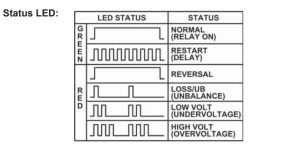KoalaWala
Member
Hey guys, thanks for taking the time to look into my question. I'm building a system to monitor several other systems for faults and one of the things I want to monitor is our incoming electrical power as we have a lot of issues with it.
If there's a fault in the system, it will send everyone who needs to know, a text message. I was thinking it would really be nice if I could have the messages be a little more specific than just "Electrical Failure from Service 1"
I found a device that monitors several different kinds of issues and returns the specific problem in the form of a blinking LED light. (see attached picture) Is there a way to capture those various pulses from the LED to an input, and have the PLC trigger a different output for each issue?

If there's a fault in the system, it will send everyone who needs to know, a text message. I was thinking it would really be nice if I could have the messages be a little more specific than just "Electrical Failure from Service 1"
I found a device that monitors several different kinds of issues and returns the specific problem in the form of a blinking LED light. (see attached picture) Is there a way to capture those various pulses from the LED to an input, and have the PLC trigger a different output for each issue?




